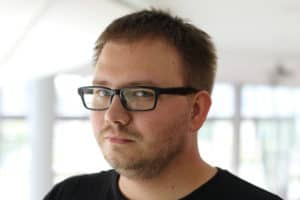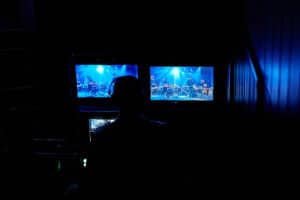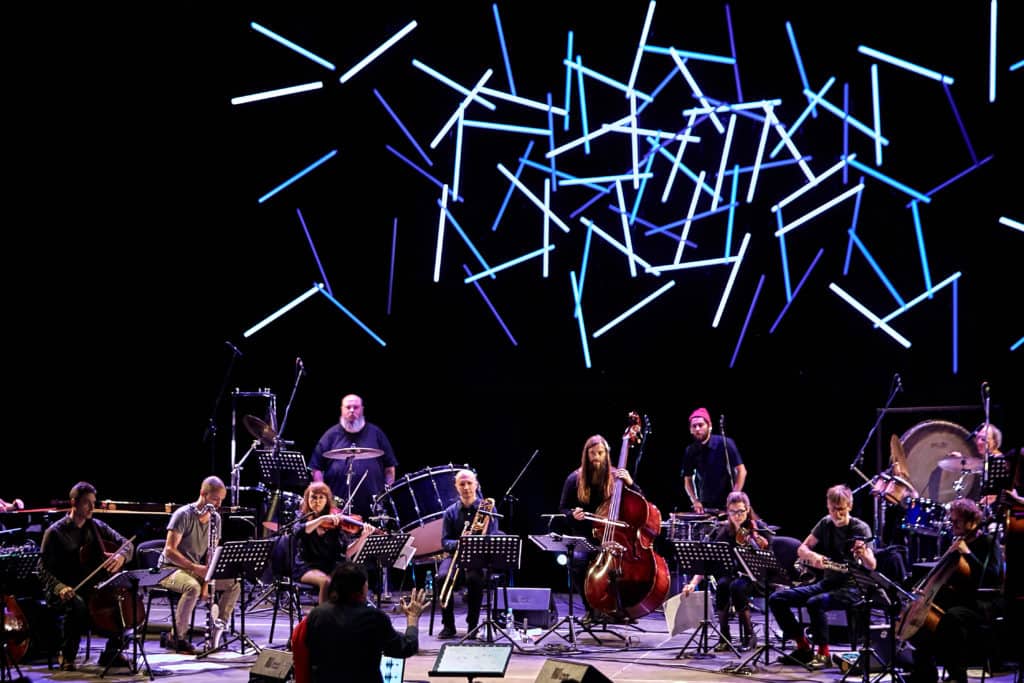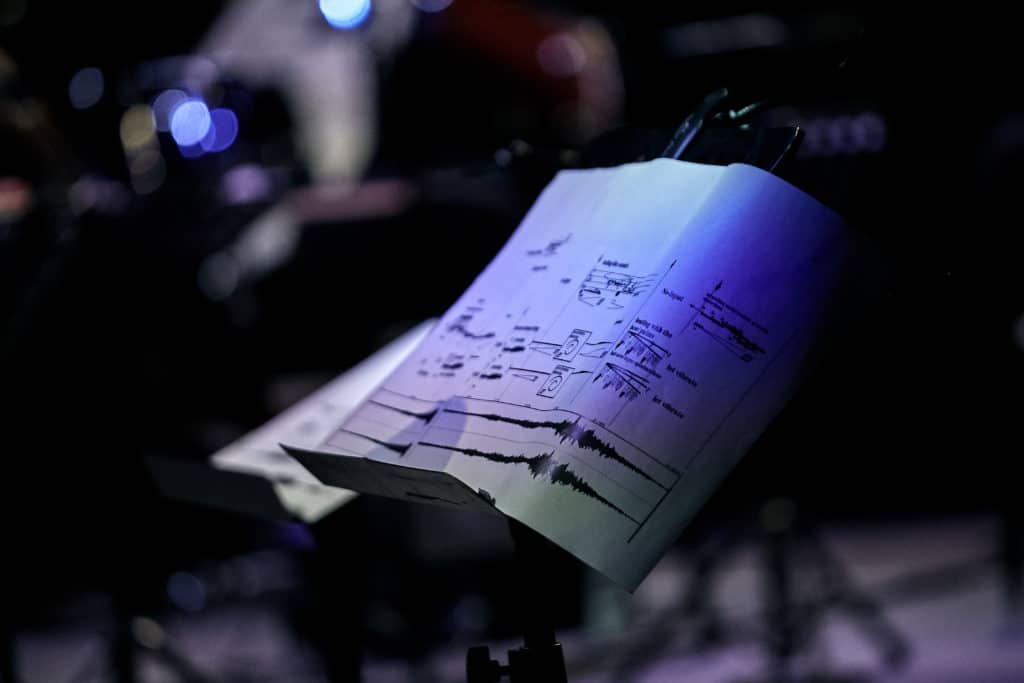Ania Prokop speaks to Krzysztof Pietraszewski, the curator of Cracow’s Sacrum Profanum festival, about sound evolutions, changes in the concept and form of the festival, and this year’s theme of “discomfort zone” – referring to the challenges, boredom and patience in music.

Krzysztof Pietraszewski, photo Szymon Witkowski
Ania Prokop: The concept of the Sacrum Profanum festival has undergone serious changes since 2003 – could you tell us about those transformations?
Krzysztof Pietraszewski: The history of the festival dates back into the past; the latest festival will be the fifteenth one in running. It has changed over the years by way of the decisions of my predecessors, Paweł Orski and Anna Oberc, and later under Filip Berkowicz. Sacrum Profanum now is held in a completely different venue than the first one. The name carries a different meaning now. In the beginning it was just a festival for secular and church music, mostly 17th and 18th century music, and we added 19th century music in time. The festival later changed in format and, subsequently, music from various countries was also presented, from Russia, through the US, the UK, France, Germany etc. Since 2008, the focus of the festival has mainly been modern music, which is broadly understood as 20th century music. This evolution has continued.
Over a short period of time, we have found ourselves dealing with a festival whose initial assumptions have changed, but it took place by way of an evolution, not a revolution. The next step was the combination of various musical and aesthetic worlds, which means that the meaning of “sacrum profanum” also changed. Sacrum Profanum combined contemporary music with ambitious entertainment – for example, the German music week concluded spectacularly with a finale set by Kraftwerk. The last three years of the festival, under the supervision of director Berkowicz, have been an attempt to explore the area between entertainment music and contemporary music, through cooperating with musicians who play in rock bands or create electronic music. The most prominent figures of Berkowicz’s versions were Richard Reed Parry, Bryce Dessner, Ólafur Arnalds, among others.
Since I took the position of the festival’s curator last year, the direction and the meaning of the name have changed slightly. Our aim is still to juxtapose extreme and contrasting notions. It is contemporary academic music on the one hand, and on the other hand experimental, avant garde music, although the notions have been changing their meanings year by year, decade by decade. “The meeting” is crucial to me. I would like to arrange it both on the stage as well as among the audience, to facilitate the exchange of thought, views and ideas. Sacrum Profanum has been trying to reach a wide audience since the very beginning, hence the “Profanum”. We leave the philharmonics, combine academic music with other musical genres which are more popular among the public, in order to draw attention to something else. It has always been the objective of the festival, even when it was just a secular and church music festival, because even back then a series of concerts was concluded with a huge show in Sendzimir Steelworks. The assumption has not changed. Whereas, over the last two years, I have been observing the reality around me and attempting to respond to what I see – either by commenting on it or introducing a form of reconstruction, sometimes by co-creating the reality by addressing important social or political issues.
A. P.: Quoting Jennifer Walshe, “everything is important,” just as you put it in your curatorial article. You can see a substantial difference between the first and the more recent editions in the number of new types of events at the festival. I’m especially thinking about last year’s sound installation by Paweł Kulczyński entitled “shibboleth”, and other such elements of the festival which move beyond the “classical” and widespread perception of music.
K. P.: There were many things like that last year, but last year’s edition was special in that respect. For me, it was the time and space to present the widest possible range of future musical interests which will appear at the festival while I’m curator.
A. P.: Was that your little manifesto?
K. P.: Yes, you can take it that way. The objective of that activity was to show that contemporary music is not only a concert, a piece of music performed on stage for audiences, but it is also opera, musical theatre, sound installations, workshops for amateurs and professionals. In addition, we would also like to prove that it is worth talking about music, hence the meetings and discussions accompanying the festival. As a matter of fact, we do not have such diversity of forms this year. Although it is not only a festival of concerts, because we have planned workshops with Michał Górczyński and Jeniffer Walshe, as I have mentioned before. There are accompanying meetings, during which we will be able to speak of music from a more or less specialist point of view. We have planned meetings dedicated to Romanian literature, in order to present more context for the country and the circumstances in which the music – Romanian spectral music, which is included in the festival’s events – is created. It is strongly associated with the culture of this country and its traditions.
The concerts themselves take on different forms. Sometimes they encourage the unusual reception of music, such as Pauline Oliveros’s compositions called “meditations”: the audience will be able to listen to her piece in three various spaces at once, moving around and listening to their own version of the work. The sounds will be projected through eight channels, so in each location of this large space, it will be possible to listen to a different version of the piece, fragments, while lying down on a pouf or walking around. We can decide what the music ultimately means to us ourselves.
We are also planning an opera for children, multimedia concerts, and much more. We are trying to cater to a wide range of needs for an audience which expects much more from culture than just obtaining a ready-made outcome.
A.P.: Since we have mentioned “Romanian spectral music”, with which I have been tormenting myself lately, and we have spoken of the name “Sacrum Profanum”, why have you decided to choose “the discomfort zone” as your leitmotif?
K.P.: This is a part of the festival’s marketing strategy. I say this with full awareness. I haven’t spoken about that in such a way before but, that’s what it is. It is a deliberate use of mechanisms borrowed from “personal development” strategies on the one hand, and from modern-day marketing on the other. It clearly shows our perverse approach to promoting the festival, which is for it to become a form of challenge our audience has to face. The audience has not found its way to the festival yet, people have heard about it, but thought that “it was not music”, or “the things happening there were too demanding, requiring careful preparation”. We are challenging these stereotypes. We will encourage the attendees to leave their comfort zones and revise their convictions, in other words to form their own independent opinions. Check for yourself how you would react to this kind of contemporary art – as it is sometimes more than music – what emotions it will evoke, what impressions it will leave. Without a shadow of doubt, I can guarantee that there will be “reactions” – even if it is anger and the thought that “I can do this too”, it is still worth experiencing. We wanted to give the audience an opportunity to experiment with art and test themselves.
In view of all that, there is awareness that Kraków is currently the largest outsourcing centre in Poland. The language we have decided to use is the language with which we are able to reach the most numerous work sector in Kraków, to people working in corporations. Such references to personal development stimulate our imagination, and I think that it is a part of the market which needs to be catered for culture-wise. Those people working there want contacts with culture and it is worth remembering that while organising cultural events in Kraków.
A.P.: In your curatorial article, you wrote “if you lose the thread while reading a longer article […] take up the challenge and come to a three or four-hour-long concert.” You also added that “the rich cultural proposal is hastily consumed by viewers who get bored quickly.” You explained the nature of your challenge and why it is worth facing, but I am still curious by the notion of “boredom.” Is the feeling of boredom the reason why we surf through a list of pieces of music on Soundcloud or are not able to listen to a 3-hour-long concert, or is it the continuous feeling of pressure and the need to stay up-to-date of what is going on in music and culture?
K.P.: I believe that both options are possible and true. It depends on the individual person. It might result from boredom in the case of one person, but in the other it is connected with something called fomo (fear of missing-out), which is the need for staying up-to-date, the fear of being suspected of missing something important, something which everyone is speaking of. The festival provides an opportunity to work on oneself, an opportunity to fight your habits. However, on the other hand, the festival includes over 20 concerts in 6 days, so it is impossible to take part in all of them – although I still will. There were two premises behind intensifying the festival. The first one – to make Sacrum Profanum a real festival experience, understood as a celebration of music, a space to discover new artists, aesthetics, new music. It is attainable with such accumulation. The second reason is the willingness to make it easier for people from outside Kraków to participate in a larger part of the festival in a more effective and efficient way. Even if you just come for the weekend, it is possible to take part in 9 out of 20 concerts, not taking Friday into account. It is nearly a half of the festival, and only one weekend. The whole of the festival, considering both the programme and the form, is an attempt to juxtapose extremities: on the one hand to depict the things happening around us – excessive intensification of experience, impressions and messages attacking us from every direction – on the other hand, to find a way to escape this overloading. Just how you escape from the hustle and bustle of the city to nature, somewhere to the countryside…
A.P.: It can get noisy there too.
K.P.: True, the area around Zakopane, the Tatra Mountains can be worse than the city… but there are places where you can take a deep breath, and there will be such spots at the festival, where viewers will be able to escape from the intensity of the rest of the programme. For instance, “drone” or “meditations” are concerts during which time will, in a sense, stop. I hope that the people who decide to attend them, will treat them as a moment to take a rest from the festival, while still taking part in it.
A.P.: In my earlier question about boredom, I meant to ask if you think that we listen to music differently now than in the past? I get the impression that our conversation leads to a general conclusion that we have become a less patient audience.
K.P.: Of course, the fact that we are discussing the issue is kind of a generalisation. Reception of music differs depending on the individual listener. There are numerous exceptions from every rule. For example, I value the last season of Twin Peaks and I often give it as an example which a large proportion of readers could relate to. The season is widely criticised for long drawn-out passages, lack of dynamics or a large dose of abstract elements. Lynch’s work is in general criticised for being too artistic, not traditional or “human” enough. This is what made the series different from everything we’ve had a chance to watch. Just as the older episodes. As a matter of fact, I look for something distinct in culture – in music, film, and in theatre as well. I always find something valuable in this other outlook. Slow montage or long scenes are not indifferent to us too. For example, the drawn-out journey scene in the last episode of Twin Peaks – don’t be afraid, it’ not a spoiler – in which agent Cooper drives for over 20 minutes. It is a scene which makes us uncomfortable, it drags on making us lose patience, but at the same time it builds on the tension, we are wondering what will happen when he gets to his destination. We notice the fact that there is a destination of his journey. The change of place, time, and space is even more conspicuous than expected. We start noticing things – besides the evoked emotions – which we would normally ignore. If the scene was 30 seconds long, we wouldn’t be talking about it at the moment. It would now be appropriate to watch the whole season and find out how crucial the journey is. Expanding, and slowing down is often a measure aimed at evoking a specific reaction of the audience. That is the case in Pauline Oliveros’s music. She has been encouraging people to listen profoundly all her life, with your whole body, your whole self, to listen carefully to the sounds, in short – to treat music in a meditative way and to breathe with music, to live music. The measures, minimalism and reductionism, are not a play on the listeners, or hiding insufficient technical skills under a lavish artistic form… They are often thoroughly thought out ideas for musical compositions or some other means of artistic expression, specific strategies in the creator-recipient relation.
A.P.: During this year’s edition you will present a lot of colourful bright personalities. Could you tell us about some of them?
K.P.: This year’s programme was built around a few figures who – simply put – have something interesting to say, or have had an intriguing life.
– Julius Eastman – an Afro-American gay man who created music in the 1970s in the USA. A totally uncompromising figure, deeply engaged in social and political affairs. That is the reason he was treated as an outsider.
– Moondog – a blind musician, a composer, and a creator of instruments. A very colourful person, who plays in New York’s 6th Alley dressed as a Viking. His work was appreciated by Philip Glass and other members of New York’s bohemia. Unfortunately, he died forgotten in America but has been rediscovered in Europe.
– Jennifer Walshe – The new hope for a new discipline amid post-internet aesthetics, who depicts this tangle and the chaos around us in a skilful and colourful way. What I like about her work is the blurring of the boundary between truth and falsehood, because this is something we need to deal with every day on the Internet.
– Gideon Alorwoyie – Steve Reich’s master. Reich’s minimalism has evolved from a form based on a loop to rhythmic music. This turn took place in the 1970s after a visit to Ghana. After studying with Gideon, a twist emerged. This twist has caused a surge of changes in music, not only classical, or minimalism, but also in popular music like dance or electronic music. Often attributed to minimalists, mainly Reich, but we wanted to show that the twist’s source lies in Ghana with Gideon’s.
– Alvin Lucier – a person you could write a book about. Briefly speaking, Lucier is the creator of minimalism. I like perceiving him as a composer whose greatest inspiration was science, and who loved to deal with the laws of nature or physics in his works.
– Iancu Dumitrescu and Ana-Maria Avram – A great couple who unfortunately will not be able to come to the festival together because Ana-Maria Avram passed away at the beginning of August. It is a tremendous loss for Romanian spectral music, because together they were the greatest promoters, creators and performers of spectral music. They also have a publishing house and a festival dedicated to Romanian spectralism.
There are more of such figures whose lives would make great films. Their works tell their life stories in the best way. If you take a closer look at Eastman’s compositions, it is easy to imagine his figure. Maybe it is just an impression if you happen to know both? During the festival the music of these wonderful artists will be co-created by the most suitable people, for example, Eastman’s music will be presented by S.E.M. Ensemble co-founded by Eastman. Moondog’s music will be performed by French ensembles who have been trying to recreate his works for years. Some of these performers are iconic to certain interested groups and who can attract an audience to the festival. The list includes Natalia Przybysz and Tomasz Stańko, Oren Ambarchi and Stephen O’Malley and Murcof and Lubomyr Melnyk. They are stars of alternative music genres.
This festival is different from previous editions due to the absence of one clear point of reference – a lantern; a headliner who would draw everyone’s attention. Through the multitude of protagonists and as far as the composition and the performance is concerned, it is easier to perceive the festival’s programme as a whole where everyone is equally important. The viewer’s task is to consciously choose performers which are interesting to them, not just be guided by a headliner and take the easy way. This is the only point, which is not an encouragement and a bow to the audience. We make things a bit more difficult by not allowing the audience to get directed by a poster. We would like the audience to study the programme and make their own decisions. It would be best if they enter their ‘discomfort zone’ with the help of artists who seem to be the most attractive, or the most interesting option to them.
Interviewed by Anna Prokop
Translated by Monika Mokrosz
Edited by Mannika Mishra
















